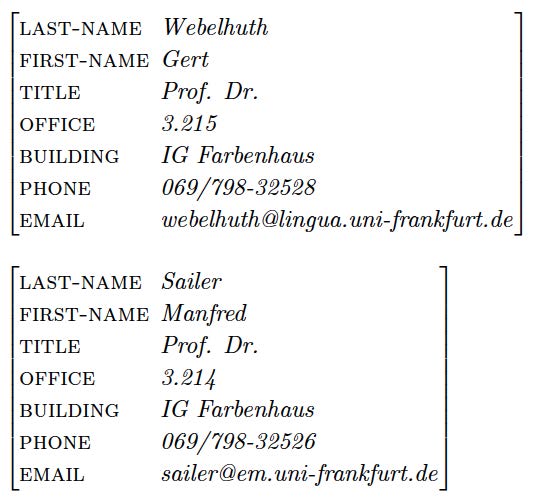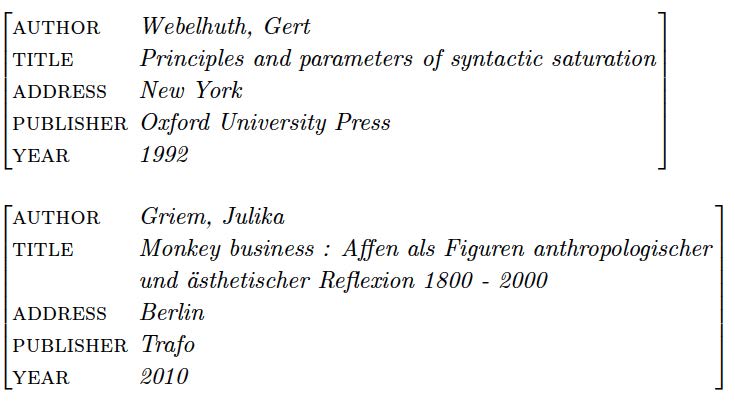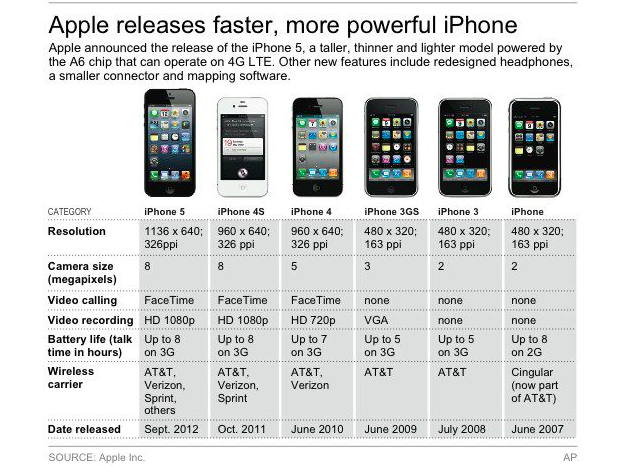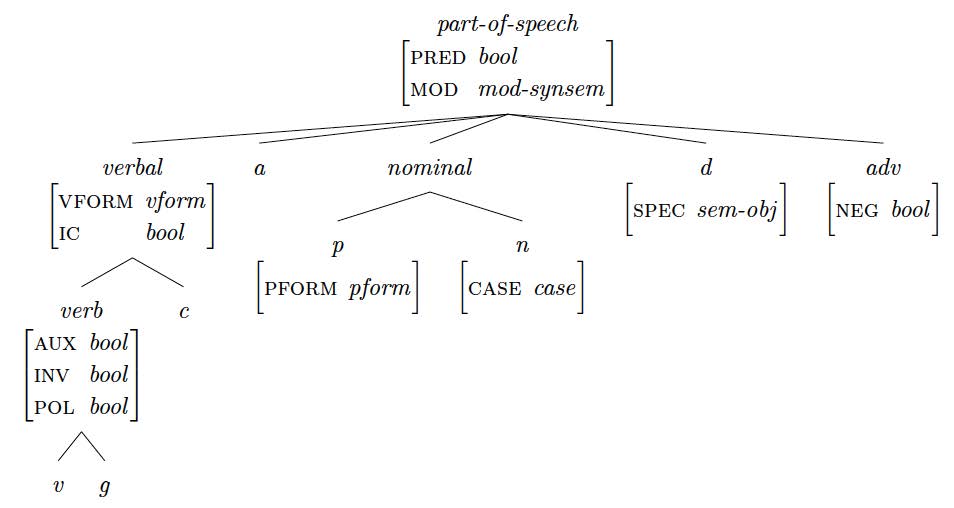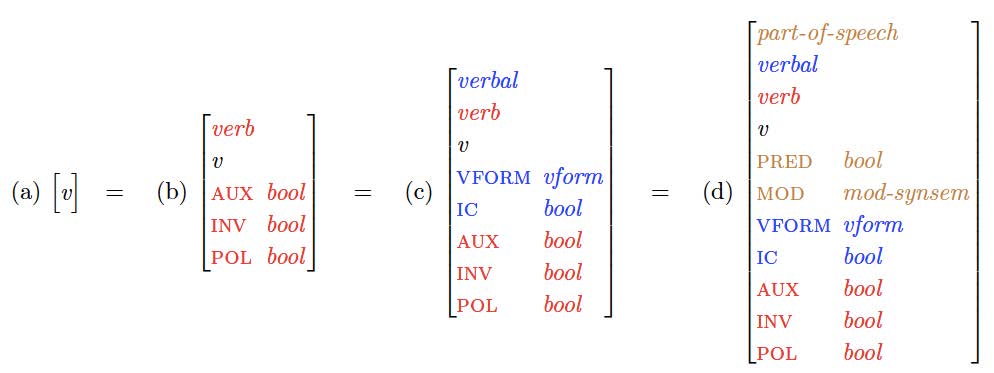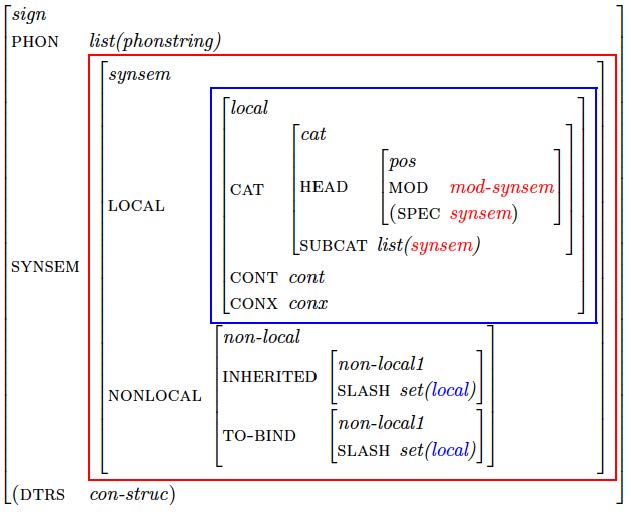|
|
| (55 intermediate revisions by the same user not shown) |
| Line 1: |
Line 1: |
| == Syntax 1 Wiki ==
| | [[Syntax_1_Wiki|Syntax 1 Wiki]] |
|
| |
|
| | [[Constraint-based_Syntax_2|Syntax 2]] |
|
| |
|
| <font face="Arial, Helvetica, sans-serif">
| |
| <font size="3">
| |
|
| |
|
| === Words ===
| |
|
| |
|
| Syntax deals with the question of how the phrases of a language are built up from smaller phrases and words.
| | [[Grammar-Writing|Grammar Writing]] |
|
| |
|
| === Parts of Speech ===
| | [[GS-2000|Ginzburg and Sag (2000)]] |
|
| |
|
| Every English word belongs to a '''part of speech''' like ''noun'', ''verb'', or ''adjective'', and many words belong to more than one (for instance, the word cook can be a noun or a verb). You can think of a part of speech as a set of words that share some grammatical property, e.g. nouns often refer to objects and can be singular or plural, verbs often refer to event and can appear with different tense affixes, etc.
| | [[HPSG|Head-Driven Phrase Structure Grammar]] |
|
| |
|
| Thus, for every part of speech, there are a number of tests that one can use to check whether a given word belongs to that part of speech. While there are certain cases where the tests to not give a clear result on the part of speech of a word, the typical situation is one where the tests unambiguously favor one part of speech over the others.
| | [[Syntax_1_Wiki_Aenderungen|Syntax 1 Wiki: Änderungen]] |
|
| |
|
| In the following sections, we present the tests for each part of speech.
| |
|
| |
|
| ==Nouns== | | <center> |
| | <embedvideo service="youtube" dimensions="400">https://www.youtube.com/watch?v=JRiX8Jiq_Z4</embedvideo> |
| | </center> |
|
| |
|
| * semantic test:
| |
| ** Nouns name persons, things or places
| |
| * morphological test:
| |
| ** Nouns can combine with a plural morpheme (-(e)s)
| |
| * syntactic test
| |
| ** Nouns can occur with the possessive 's, i.e. in the environment:
| |
| *__ 's
| |
| ** Nouns can occur between a determiner and a verb, i.e. in the environment: Det __ V
| |
|
| |
|
| ==Verbs==
| | [ Parts of the clause] |
| *semantic test:
| |
| **Verbs refer to actions
| |
| *morphological test:
| |
| **Verbs can combine with a 3rd singular inflection (-(e)s)
| |
| **Verbs can combine with a past tense inflection (-ed)
| |
| **Verbs can combine with -ing (in the contexts: __-ing can be fun, Pat was __-ing)
| |
| *syntactic test
| |
| **Verbs can occur directly after can: They can __ ...
| |
| *Verbs can occur directly after wanted to: Pat wanted to __ ...
| |
|
| |
|
| ==Adjectives==
| | <!-- This is a comment --> |
| *semantic test:
| | ∀''x'' ('''cat'''(''x'') : ∃''y''('''likes(''y'', ''x'')) |
| **Adjectives refer to properties
| | ⊃ ∧ ¬ ∨ ≡ ∀ ∃ æ ⊕ Ø ⇒ <u>Unterstrichen</u> → ⇒ |
| *morphological test:
| | |
| **Adjectives can combine with comparative and superlative markers (-er/-est, or more/most)
| | Text davor |
| **Adjectives can combine with -ly to form an adverb
| | <blockquote>Blockquote</blockquote> |
| *syntactic test
| | Text danach |
| **Adjectives can be between a determiner and a noun, i.e. in the environment ('attributive use'):\\ Det __ N (Pat read the __ book.)
| |
| **Adjectives can occur in the following copula ('linking') verbs ('predicative use'): They felt/seemed/sounded __
| |
|
| |
|
| ==Adverbs==
| |
| *semantic test:
| |
| **Adverbs refer to the manner, location, time or frequency of an action
| |
| *morphological test: -
| |
| *syntactic test
| |
| **Adverbs can occur in the following diagnostic environment: Pat treats Chris very __
| |
|
| |
|
| ==Prepositions==
| |
|
| |
|
| *there is no clear semantic criterion.
| | <font face="Arial, Helvetica, sans-serif"> |
| *since prepositions don't show morphological change in English, there is no morphological criterion either.
| | <font size="3"> |
| *synctactic test:
| |
| **Prepositions occur right before an NP, i.e. in the environment: __ NP
| |
| | |
| ==Minor Parts of Speech==
| |
| General characteristics:
| |
| * the word classes can be defined by listing all elements.
| |
| * the words of minor parts of speech have a 'grammatical' meaning, i.e. they are function words. They express a grammatical, meta-linguistic or indexical function.
| |
| closed word classes (i.e. new words in the language will not belong to any of these classes)
| |
| * diachronically words of minor parts of speech emerge and disappear very slowly if at all. A change in a minor class usually goes hand in hand with a change in the grammar.
| |
| * they are heterogeneous and difficult to group. Therefore, we cannot provide tests, but since we are dealing with closed classes, we can provide listings.
| |
| | |
| These properties contrast with those of the major parts of speech.
| |
| | |
| | |
| | |
| | |
| | |
| | |
| | |
| | |
| <quiz display=simple> | |
| {Determine the part of speech of the words in the sentence.<br /> Use the following part of speech labels: A, Adv, Cj, C, D, N, P, V
| |
| |type="{}"}
| |
| | |
| Alex/{ N _5 } talked/{ V _5 } to/{ P _5 } my/{ D _5 } best/{ A _5 } friend/{ N _5 }.
| |
| || Solution: N V P D A N
| |
| </quiz>
| |
| | |
| <quiz display=simple>
| |
| {Determine the part of speech of the words in the sentence.<br />Use the following part of speech labels: A, Adv, Cj, C, D, N, P, V
| |
| |type="{}"}
| |
| | |
| You/{ N _5 } might/{ V _5 } suspect/{ V _5 } that/{ C _5 } Pat/{ N _5 } is/{ V _5 } a/{ D _3 } genius/{ N _5}.
| |
| || Solution: N V V C N V D N
| |
| </quiz>
| |
| | |
| <quiz display=simple>
| |
| {Determine the part of speech of the words in the sentence.<br />Use the following part of speech labels: A, Adv, Cj, C, D, N, P, V
| |
| |type="{}"}
| |
| | |
| The/{ D _5} title/{ N _5 } of/{ P _5 } a/{ D _5 } book/{ N _5 } largely/{ Adv _5 }
| |
| || Solution: D N P D N Adv V
| |
| | |
| determines/{ V _5 } whether/{ C _5 } it/{ N _5 } will/{ V _5 } be/{ V _5 } successful/{ A _5 } or/{ Cj _5 } a/{ D _5 } flop/{ N _5 }.
| |
| || Solution: V C N V V A Cj D N
| |
| </quiz>
| |
| | |
| === Semantic analysis of sentences into predicates and arguments ===
| |
| | |
| Note: Many of the sentences in this section are taken from or based on examples in Hornby, A.S. (1975) Guide to Patterns and Usage in English. Second Edition. Cornelsen & Oxford University Press.
| |
| | |
| <quiz display=simple>
| |
| { Fill in the gaps!
| |
| | |
| ''Example:'' <span style="color: blue>You <u>surprised</u> them.</span>
| |
| | type="{}" }
| |
| | |
| Predicate: { x surprises y _15}
| |
| | |
| x = { You _10}
| |
| y = { them _10}
| |
| z = { - _10}
| |
| </quiz>
| |
| | |
| <quiz display=simple>
| |
| { Fill in the gaps!
| |
| | |
| ''Example:'' <span style="color: blue>We went to Wales.</span>
| |
| | type="{}" }
| |
| | |
| Predicate: { x goes y _15}
| |
| | |
| x = { We _10}
| |
| y = { Wales _10}
| |
| z = { - _10}
| |
| </quiz>
| |
| | |
| | |
| <quiz display=simple>
| |
| { Fill in the gaps!
| |
| | |
| ''Example:'' <span style="color: blue>The plane landed.</span>
| |
| | type="{}" }
| |
| | |
| Predicate: { x landed _15}
| |
| | |
| x = { The plane _10}
| |
| y = { - _10}
| |
| z = { - _10}
| |
| </quiz>
| |
| | |
| <quiz display=simple>
| |
| { Fill in the gaps!
| |
| | |
| ''Example:'' <span style="color: blue>Steven met my most favorite teacher.</span>
| |
| | type="{}" }
| |
| | |
| Predicate: { x meets y _15}
| |
| | |
| x = { Steven _10}
| |
| y = { my most favorite teacher_30}
| |
| z = { - _10}
| |
| </quiz>
| |
| | |
| <quiz display=simple>
| |
| { Fill in the gaps!
| |
| | |
| ''Example:'' <span style="color: blue>She said that it would rain.</span>
| |
| | type="{}" }
| |
| | |
| Predicate: { x says y _15}
| |
| | |
| x = { She _10}
| |
| y = { that it would rain _25}
| |
| z = { - _10}
| |
| </quiz>
| |
| | |
| <quiz display=simple> | |
| { Fill in the gaps!
| |
| | |
| ''Example:'' <span style="color: blue>Many of his friends consider Joe somewhat arrogant.</span>
| |
| | type="{}" }
| |
| | |
| Predicate: { x consider y z _15}
| |
| | |
| x = { Many of his friends _25}
| |
| y = { Joe _10}
| |
| z = { somewhat arrogant _20}
| |
| </quiz>
| |
| | |
| | |
| <quiz display=simple>
| |
| { Fill in the gaps!
| |
|
| |
|
| ''Example:'' <span style="color: blue>We need to talk to Lilly about her behavior.</span>
| | Font size 3 |
| | type="{}" }
| |
|
| |
|
| Predicate: { x talk y z _15}
| | </font> |
|
| |
|
| x = { We _10}
| | <span style="color: red>Text color</span> |
| y = { to Lilly _10}
| |
| z = { about her behavior _20}
| |
| </quiz> | |
|
| |
|
| <quiz display=simple> | | [<sub>NP</sub> labeled brackets ] |
| { Fill in the gaps!
| |
|
| |
|
| ''Example:'' <span style="color: blue>The plane landed.</span>
| | Superscripts<sup>1</sup> |
| | type="{}" }
| |
|
| |
|
| Predicate: { x lands _15}
| | Definitionsliste: |
|
| |
|
| x = { The plane _10}
| | ;Begriff 1 |
| y = { - _10}
| | : Beschreibung 1 |
| z = { - _10}
| | ;Begriff 2 |
| </quiz>
| | : Beschreibung 2-1 |
| | : Beschreibung 2-2 |
|
| |
|
| | Text einrücken: |
|
| |
|
| <quiz display=simple>
| | : Einfache Einrückung |
| { Fill in the gaps!
| | :: Doppelte Einrückung |
| | ::::: Mehrfache Einrückung |
|
| |
|
| ''Example:'' <span style="color: blue>I talked to her.</span>
| | Nummered list: |
| | type="{}" }
| |
|
| |
|
| Predicate: { x talks y _15}
| | # Erstes Element der ersten Ebene |
| | ## Erstes Element der zweiten Ebene |
| | ## Zweites Element der zweiten Ebene |
| | # Zweites Element |
|
| |
|
| x = { I _10}
| | Bulleted lists: |
| y = { to her _10}
| |
| z = { - _10}
| |
| </quiz>
| |
|
| |
|
| | * Erstes Element der ersten Ebene |
| | ** Erstes Element der zweiten Ebene |
| | ** Zweites Element der zweiten Ebene |
| | * Zweites Element |
|
| |
|
| <quiz display=simple>
| |
| { Fill in the gaps!
| |
|
| |
|
| ''Example:'' <span style="color: blue>We gave Lilly a bike.</span>
| |
| | type="{}" }
| |
|
| |
|
| Predicate: { x gives y z _15}
| |
|
| |
|
| x = { We _10}
| | [[File:employees.jpg]] |
| y = { Lilly _10}
| | [[File:books.jpg]] |
| z = { bike _10}
| | [[File:iphones.png]] |
| </quiz>
| | [[File:pos-jpg.jpg]] |
| | [[File:pos-v-1.jpg]] |
| | [[File:pos-v-2.jpg]] |
|
| |
|
| <quiz display=simple>
| |
| { Fill in the gaps!
| |
|
| |
|
| ''Example:'' <span style="color: blue>Someone pushed Lilly into the flowers.</span>
| |
| | type="{}" }
| |
|
| |
|
| Predicate: { x pushes y z _15}
| |
|
| |
|
| x = { Someone _10}
| |
| y = { Lilly _10}
| |
| z = { into the flowers _20}
| |
| </quiz>
| |
|
| |
|
|
| |
|
